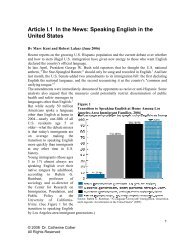Accent Reduction
Accent Reduction
Accent Reduction
You also want an ePaper? Increase the reach of your titles
YUMPU automatically turns print PDFs into web optimized ePapers that Google loves.
<strong>Accent</strong> <strong>Reduction</strong><br />
Emma Williams<br />
Carrie Anderson<br />
Mollie Nelson
Everyone has an<br />
<strong>Accent</strong><br />
There is no such thing as<br />
unaccented English, or any<br />
language.
What is <strong>Accent</strong> <strong>Reduction</strong>?<br />
<strong>Accent</strong> <strong>Reduction</strong> is a type of speech<br />
therapy wherein a speaker’s accent,<br />
whether the result of their regional<br />
dialect, or the result of their first<br />
language, is altered to aid in<br />
communication.
What is an accent?<br />
Prosodic features<br />
Segmental<br />
features<br />
According to Lippi-<br />
Green (1997)<br />
“<strong>Accent</strong>s are loose<br />
bundles of prosodic<br />
and segmental<br />
features distributed<br />
over geographic<br />
and/or social space”<br />
(p. 42)
<strong>Accent</strong> <strong>Reduction</strong> Processes<br />
Prosodic<br />
Features<br />
Muscularity<br />
Pronunciation
Prosodic Features<br />
The acoustic properties of speech<br />
• Rhythm<br />
• Stress<br />
• Pitch
Prosody<br />
Standard Pattern: Jump Up and Step<br />
Down Formation<br />
• Context Words<br />
• Function Words<br />
ve-<br />
ry hap- py to<br />
meet you<br />
I’m
Prosody, cont.<br />
Stress<br />
• I didn’t say he stole the money.<br />
• I didn’t say he stole the money.<br />
• I didn’t say he stole the money.<br />
• I didn’t say he stole the money.<br />
• I didn’t say he stole the money.<br />
• I didn’t say he stole the money.<br />
• I didn’t say he stole the money.
Synthetic and Analytic<br />
Languages<br />
Analytic Languages are languages in<br />
which word order signifies meaning<br />
Synthetic Languages are languages in<br />
which suffixes and prefixes are used to<br />
signify meaning
Muscularity<br />
Which muscles do<br />
you use to create<br />
language?<br />
Places of Articulation<br />
Mid-Tongue Circular<br />
• How American<br />
sounds are created
Pronunciation<br />
Familiarity with IPA<br />
Familiarity with<br />
target language<br />
sounds
‘Standard English’<br />
A myth and misconception
Why Reduce or Eliminate<br />
an <strong>Accent</strong>?<br />
Discrimination as a result of an accent<br />
• Lippi-Green (1997) uses the term “litmus<br />
test for exclusion” (p. 123)<br />
They don’t want to appear uneducated<br />
Success in career
Do accents render a speaker<br />
unable to communicate?<br />
Lippi-Green (1997) Listeners: Accepting<br />
or rejecting the “act of communication”
Does the language<br />
background of the<br />
English L2 speaker<br />
make it easier for<br />
them to<br />
communicate with<br />
a speaker with a<br />
similar language<br />
background?
Derwing and Munro’s (2006)<br />
three dimensions of L2<br />
communication<br />
Intelligibility<br />
Comprehensibility<br />
<strong>Accent</strong>edness
The Mutual Intelligibility of<br />
L2 Speech (Derwing and<br />
Munro, 2006)
Foreign Language, Comprehensibility,<br />
and the Intelligibility in the Speech of<br />
Second Language Learners<br />
Derwing and Munro (1995) found, “that<br />
even heavily accented speech is<br />
sometimes perfectly intelligible and that<br />
prosodic errors appear to be a more<br />
potent force in the loss of intelligibility<br />
than phonetic errors” (p. 73)<br />
Segmental errors then, are less<br />
important than prosodic errors to the<br />
comprehensibility of speech
What does this mean for<br />
TESOL teachers?<br />
Intelligibility<br />
Grammar/vocabulary<br />
Grammar/Vocabulary
<strong>Accent</strong> <strong>Reduction</strong><br />
Techniques<br />
Speech Language Pathology<br />
Models and Applications<br />
• Compton P-ESL: Pronouncing English as a<br />
Second Language<br />
• Reverse <strong>Accent</strong> Mimicry: An <strong>Accent</strong><br />
<strong>Reduction</strong> Technique for Second<br />
Language Learners
Compton P-ESL: Pronouncing<br />
English as a Second Language<br />
Target Pronunciation<br />
• Prosody<br />
• Voice Projection and Intonation<br />
• Tone and Volume<br />
Non-Verbal Skills<br />
• Body Language<br />
• Eye Contact
Examples of Pronunciation<br />
Errors<br />
The English letters ‘L’ and ‘R’ are often<br />
confused by L2 Asian Speakers<br />
The English sound ‘th’ often gets<br />
pronounced with an ‘S’ and ‘Z’ for many<br />
different speakers<br />
Phonetic vowel sounds
Reverse <strong>Accent</strong> Mimicry<br />
Model<br />
<strong>Accent</strong> <strong>Reduction</strong> Therapy<br />
• Founded by Laurence M. Hilton, Speech-Language<br />
Pathologist (University of Nebraska)<br />
• Pronunciation and Prosody<br />
“Humans possess an innate biological capacity<br />
to hear, differentiate and mimic fundamental<br />
prosodic and phonological characteristics of<br />
any language” (Rizzolatti, Fadiga, Gallese, &<br />
Fogassi 1996; Skoyles, 1998, as cited in Hilton,<br />
2005)
Reverse <strong>Accent</strong> Mimicry,<br />
cont.<br />
Step 1: Identify or Provide a Desirable<br />
Reverse <strong>Accent</strong> Model for each Speaker<br />
• Real Persons: friends, teachers, neighbors<br />
• Media Models: Speakers from movies,<br />
television, etc.
Reverse <strong>Accent</strong> Mimicry,<br />
cont.<br />
Step 2: Triggering the Holistic Mimicry<br />
Effect in L1<br />
• Direct Mimicry<br />
• Native Language
Reverse <strong>Accent</strong> Mimicry, cont.<br />
Step 3: Transitioning to L2 Reverse<br />
<strong>Accent</strong> Mimicry
Reverse <strong>Accent</strong> Mimicry, cont.<br />
Step 4: Guided Use and Generalization
Conclusion<br />
Everyone has an accent! ☺<br />
<strong>Accent</strong>s are personal reflections of who we<br />
are– our culture, our background, and our<br />
individual expression and communication<br />
<strong>Accent</strong> <strong>Reduction</strong> techniques are often used to<br />
increase the effectiveness of communication,<br />
but also often utilized by people to overcome<br />
discrimination that arises as a result of the<br />
negative connotations associated with a heavy<br />
accent.
The End<br />
El Fin<br />
La Fin<br />
La Fine<br />
Das Ende<br />
Конец<br />
終 わり<br />
終 止
References<br />
Hilton, L.M. (2005). Reverse <strong>Accent</strong><br />
Mimicry: An <strong>Accent</strong> <strong>Reduction</strong><br />
Technique for Second Language<br />
Learners. The Internet TESL Journal,<br />
Vol. XI, No. 1. http://iteslj.org/ Lippi-<br />
Green, R. (1997). English with an<br />
<strong>Accent</strong>: Language, Ideology, and<br />
Discrimination in the United States. New<br />
York: Routledge.
References, cont.<br />
Munro, J.M. and Derwing, T.M. (1995).<br />
Foreign <strong>Accent</strong>, Comprehensibility and<br />
Intelligibility in the Speech of Second<br />
Language Learners. Language Learning,<br />
vol. 45 no.1 p73-97.<br />
Munro, J.M. and Derwing, T.M. (2006).<br />
The Mutual Intelligibility of L2 Speech.<br />
New York: Cambridge University Press.
References, cont.<br />
Sacks, T., personal communication, May<br />
11 th , 2007.<br />
Skillman, T., personal communication, May<br />
14 th , 2007<br />
Stern, D. (Producer & Director). (1991).<br />
Breaking the <strong>Accent</strong> Barrier [Video<br />
Recording]. Available from Video<br />
Language Products).

















